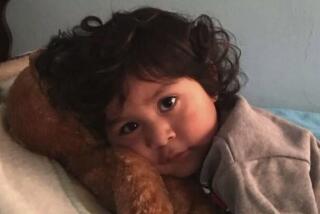Who Gets the Children? Clarifying Joint Custody
- Share via
New state legislation and recent studies put the question of child custody in the news again.
Senate Bill 1306, recently signed into law by Gov. George Deukmejian, underscores California’s commitment to securing an arrangement in the child’s best interest, with no preference for joint or sole custody.
This bill, along with two studies by the Center for Families in Transition in Marin County, have revived the issue. Some of the media, in a rush for controversy, have pushed these studies far beyond what the authors intended. The studies and the passage of SB 1306 raise important questions, but one of those questions is not “does joint custody work?”
One of the deepest, most primitive needs is a parent’s connection to his or her offspring, a connection almost as fundamental as life itself. Child custody disputes may be the most intense and bitter of all family battles.
Until the early 1800s, custody was awarded to fathers. Fathers usually outlived mothers, who often died in child-birth. Fathers were the economic head of the family. Percy Bysshe Shelley, better known as a poet, helped change this pattern. In his celebrated case, the court recognized Mary Wollstonecraft--author of “Frankenstein”--as the better parent. By awarding custody to her, the court began the “tender years doctrine” and the doctrine of maternal preference.
Freudian psychoanalytic theory completed the circle, establishing up until 1973 a maternal preference . Anna Freud, with psychiatrist Albert Solnit and law professor Joseph Goldstein, published “Beyond the Best Interest of Children,” an influential text in the early 1970s articulating this point of view.
Yet society had moved a long way from the family situations of late 19th-Century Vienna. The families with which the psychoanalytic movement was most familiar had largely disappeared--or at least were not the families presenting themselves to divorce courts. By the 1970s, 63% of all married women worked outside the home; 38% of all marriages were ending in divorce and, since 1977, more than 1 million families each year had reorganized through the process of divorce. The old formulations simply did not apply.
Like most social innovations--including the institution of marriage itself--parents began inventing sensible options to continue in the lives of their children. These experiments were personal, created without sociological research. Since the beginning of time, social institutions have grown out of the collective experience of human beings solving problems in ways that worked for them. The solution for child-rearing was labeled “joint custody.”
Robert Mnookin, in a classic study, “Bargaining in the Shadow of the Law” (Yale Law Journal, April, 1979), analyzed problems presented by the old formulations. According to Mnookin, we force parents into an adversary arena to decide the most difficult and impossible question: “Who is the ‘psychological parent?’ ” Then we award sole custody to that parent, ignoring the one option that might make sense--that both parents continue to be involved.
Fathers’ groups organized around this issue and began sponsoring legislation for joint custody. California was the fifth state to adopt this option in 1980, but California’s “frequent and continuing . . . “ language became the model for most other statutes. The history of this legislation provided important clues to some of the underlying motivations: California’s law stated it was “presumed to be in the best interest if the parents agree (to joint custody),” creating a presumption for agreement, not a presumption or a preference for joint custody. The statute allowed wide discretion between joint and sole custody when the parents did not agree, establishing the standard for decision as “the best interest of the children.”
The 1980 legislation grew out of a struggle between a bill sponsored by the Senate subcommittee on the Administration of Justice and one pushed by the fathers’ groups, who wanted a preference, or presumption for joint custody, but with a factor for the judge to consider “who would be most likely to share.” This provision was later dubbed the “friendly parent” provision by feminist critics of joint-custody legislation.
Unsuccessful attempts were later made to declare a preference or presumption for joint custody, and to establish an order of consideration, but no preference. These arguments, however, were instrumental in identifying the need to clarify California’s 1980 statute through SB 1306.
Some feminists voiced opposition to joint custody, but the women’s movement was strangely silent during much of the early debate. With the 1985 publication of the “Divorce Revolution,” however, silence ended with a roar. The opposition had found an articulate spokesperson in Lenore J. Weitzman, who advocated a “primary caretaker” standard. This position was carried in the original version of SB 1306, before the Assembly Judiciary Committee approved an amended version restating current law, holding no preference for or against joint custody.
Two claims were advanced by feminist critics:
-- Joint custody eroded the traditional role of women as caretakers of children.
-- Fathers were not as interested in taking care of children as they were interested in reducing support.
Feminist opposition to joint custody centered primarily around the latter concern.
The war over joint custody suddenly mirrored the war over individual offspring. Fathers and mothers were elevating parental rights over the needs of children. Too often, the needs of children were not represented.
How is joint custody working?
For many families and children, it works superbly. At the recent Assn. of Family and Conciliation Conference in Long Beach, three families, including their children, admitted joint custody was “hard,” but the benefits of having two families and not losing either parent was orth the effort.
Benefits included additional joint financial support by both parents beyond the age of 18, when most support awards end, and time away from the rigors of child rearing. Liabilities were some disruption in continuity and a lack of clarity for step-parents, but both the parents and the adults felt this arrangement, for the most part, was best for them. These children were doing exceptionally well at school and may have developed superior social skills, having to deal with many different personalities in two families.
The economic benefits are also supported by two studies, one American and one Canadian, indicating that joint-custody fathers were significantly more in compliance with support orders than fathers whose former wives had sole custody.
The new studies by Judith Wallerstein, Janet Johnston and others from the Center for Families in Transition indicate “joint custody” had no effect on children’s adjustment as reported by parents. The most important variables affecting adjustment were the absence of conflict between parents and the absence of pathology in either parent.
Because “joint custody” is such a relatively new concept, little or no reliable data is available to establish the benefit or detriment to children. The language, institutional supports and processes are just being defined through state laws in Washington, Florida, Maine and Vermont, where the concept of custody is being replaced by such new language as “sharing of rights and responsibilities,” “care and control” and “parenting plans.”
Joint custody works marvelously in some cases and disastrously in others. Clearly, families and courts need wide discretion to choose parenting plans best suited to the individual needs and capacities of each family and child. What is needed is clearheaded thinking, not elevated rhetoric--and certainly not an elevation of parental rights over children’s needs.
More to Read
Sign up for Essential California
The most important California stories and recommendations in your inbox every morning.
You may occasionally receive promotional content from the Los Angeles Times.










